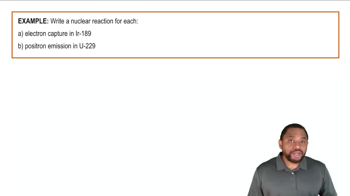Here are the essential concepts you must grasp in order to answer the question correctly.
Nuclear Fission
Nuclear fission is the process by which a heavy nucleus splits into two or more lighter nuclei, releasing a significant amount of energy. This reaction is the fundamental principle behind both nuclear power generation and atomic weapons. In power plants, controlled fission occurs to produce energy, while in weapons, an uncontrolled chain reaction is desired for explosive yield.
Recommended video:
Band of Stability: Nuclear Fission
Enrichment of Uranium
Uranium used in nuclear reactors typically contains a low percentage of the fissile isotope U-235, with the majority being U-238. For atomic weapons, uranium must be enriched to increase the proportion of U-235, making it more suitable for rapid fission. Fuel rods from power plants usually contain low-enriched uranium, which is not sufficient for weaponization without further processing.
Recommended video:
Electron Capture & Positron Emission Reaction Example
Radioactive Decay and Isotope Stability
Radioactive decay refers to the process by which unstable atomic nuclei lose energy by emitting radiation. The stability of isotopes plays a crucial role in determining their suitability for nuclear reactions. Fuel rods contain isotopes that may decay over time, and the presence of isotopes like plutonium, which can be bred from U-238 in reactors, can complicate the potential for weaponization without additional treatment.
Recommended video:
Band of Stability: Beta Decay




